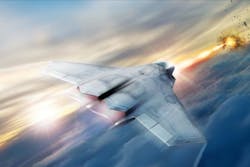Army wants tough aircraft thermal management solutions for future avionics, EW pods, and laser weapons
FORT EUSTIS, Va. – U.S. Army aviation experts are reaching out to industry for new approaches to electronics thermal management for tough-to-cool systems like avionics, laser weapons, and electronic warfare (EW) pods.
These new thermal-management approaches should be suitable for future fixed-wing airplanes and helicopters -- including the future vertical lift (FVL) aircraft -- as well as for potential upgrades to existing airframes.
Officials of the Army Contracting Command Aviation Applied Technology Directorate at Fort Eustis Va., has issued a broad agency announcement (W911W6-20-R-0007) for the $2.6 million Power And Thermal Management - Component Development (PTM-CD) project.
This initiative seeks to develop and demonstrate thermal transport connections for a modular open-systems architecture able to support a digital backbone of upgradable and swappable mission equipment for Army airplanes and helicopters.
This architecture will involve distributed hardware mounts with independent adaptable cooling connections for localized control. Thermal transport connections should provide distributed cooling plate options for electronics equipment like avionics and computer processors.
In addition, these thermal connections should be able to supply direct-line coolant for difficult transient loads like electromechanical actuators, laser diodes, laser weapons, and electronic warfare (EW) jammers.
The goal is to reduce the size, weight, and power (SWaP) consumption of aircraft thermal management systems. Of desire are technology approaches which enable SWaP reductions of aircraft main cooling units and redundant thermal management systems by enabling the aircraft to provide cooling directly.
These systems could include EW pods, high-energy lasers, and air-based heat exchangers. Army officials especially are interested in sub-ambient temperature control to extend electronics life and provide the thermal regulation necessary for increased component performance.
Related: Boeing makes five: companies to design power and thermal management for future jet fighters
The move to all-electric aircraft in the military by replacing hydraulic systems with electric motors and actuators is one of the biggest reasons for enhance electronics thermal management.
High-pulse-power systems depend not only on large amounts of electrical power to operate, but also on a strong capability to remove heat and move it around.
As more equipment switches to digital control, the aircraft requires more electricity, and different approaches to heat rejection. With the change of airframe materials to low-thermal-conductivity composite, and increased rotorcraft speed goals, mission equipment becomes more challenging to cool.
From industry, the Army wants thermal-control prototypes that could be validated in the laboratory or in simulated operating conditions.
Army officials would like to capitalize on promising prototype technologies for use in future vertical lift helicopters. Promising technologies may be integrated with those of other manufacturers in a systems integration lab.
Companies interested should email 45-page technical proposals no later than 29 June 2020 to the Army's Thomas Helms at [email protected], with a copy to Hope McClain at [email protected].
More information is online at https://beta.sam.gov/opp/b81b8d402a564ba7b72f95ecdbb702f0/view.
About the Author
John Keller
Editor-in-Chief
John Keller is the Editor-in-Chief, Military & Aerospace Electronics Magazine--provides extensive coverage and analysis of enabling electronics and optoelectronic technologies in military, space and commercial aviation applications. John has been a member of the Military & Aerospace Electronics staff since 1989 and chief editor since 1995.
